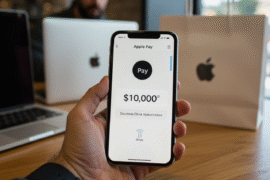This article may contain references to products or services from one or more of our advertisers or partners. We may receive compensation when you click on links to those products or services. Nonetheless, our opinions are our own.
The food and beverage industry has undergone significant transformations in recent years, largely due to advancements in technology. From the way food is produced to how it’s consumed, technology has enhanced every step of the value chain. These innovations have not only made the industry more efficient and sustainable but have also allowed businesses to cater to changing consumer demands and improve customer experiences. Below are five key ways technology is reshaping the food and beverage sector.
1. Automation in Food Production and Processing
One of the most impactful technological advancements in the food industry is the rise of automation in production and processing. Robotics and AI-driven systems are now being used to streamline the production of everything from snacks to ready-to-eat meals. Automation has improved efficiency, minimized human error, and increased production speeds while also reducing costs for manufacturers.
Robots and AI-powered machines are used for tasks such as sorting, packaging, and quality control, ensuring that products are consistent and up to standard. Additionally, automated systems in food processing are being used for tasks like cutting, mixing, and cooking, enabling faster and more uniform production. Companies like Just Eat and Miso Robotics have already implemented robotics for food preparation, showing how automation can be harnessed even in restaurant kitchens to improve food consistency and service speed.
Market Impact: The global food automation market is projected to grow substantially. According to a report by MarketsandMarkets, the food automation market is expected to reach $21.25 billion by 2026, growing at a CAGR of 7.6% from 2021. This growth highlights the rising importance of automation for improving operational efficiency and reducing labor costs in food manufacturing.
2. AI and Data Analytics for Predictive Analytics
Artificial Intelligence (AI) and big data analytics are revolutionizing the food industry by enabling predictive analytics and smarter decision-making. Food companies are now able to leverage vast amounts of data to forecast trends, manage inventory more efficiently, and predict customer behavior. This technology helps businesses optimize supply chains and reduce food waste.
AI-powered systems can analyze consumer purchasing patterns and suggest which products are likely to be in demand, allowing food companies to better prepare for seasonal shifts or new consumer preferences. Additionally, AI can also be used for recipe development, analyzing flavor profiles and customer reviews to create food products that are more likely to succeed in the market.
Market Impact: According to Grand View Research, the global AI in food and beverage market size was valued at $3.9 billion in 2020 and is expected to expand at a compound annual growth rate (CAGR) of 44.9% from 2021 to 2028. This sharp growth trajectory is driven by the increasing use of AI for product optimization and improved customer engagement.
3. Blockchain for Transparency and Food Safety
Blockchain technology, best known for its role in cryptocurrency, has also made its way into the food and beverage industry. Blockchain’s ability to provide secure and transparent data tracking is being used to ensure food safety, authenticity, and traceability. With consumers becoming more aware of the origin of their food, food companies are turning to blockchain to provide transparent supply chain tracking.
With blockchain, every step of the food’s journey can be recorded, from farm to table, giving consumers real-time information about the origin, quality, and handling of their food. For instance, brands like Walmart and Nestlé are leveraging blockchain to trace food products and ensure food safety in the event of a recall. This technology also allows food producers to quickly pinpoint the source of any contamination, which could mitigate risks to public health.
Market Impact: Blockchain technology in the food industry is gaining traction. Statista estimates that the global blockchain in food market size will reach $9.5 billion by 2025, a significant increase from $1.7 billion in 2020. This adoption is largely due to the increasing demand for food safety and transparency in the supply chain.
4. Personalized Nutrition Powered by AI and Wearables
As consumer demand for healthier, more personalized food options increases, technology is stepping up to provide tailored nutrition plans. Advances in AI, combined with wearable health devices, are enabling more personalized food recommendations based on individual needs and preferences. This is a game-changer for both consumers and businesses in the food and beverage sector.
Wearable health tech devices, such as smartwatches and fitness trackers, are collecting data on activity levels, sleep, and even heart rate. By integrating this data with AI-powered apps, consumers can receive personalized nutrition advice, including meal plans designed to meet their unique health goals. This has led to the rise of personalized meal kits and nutrition platforms like Eat This Much and Nutritional Profiling, which are gaining popularity for offering customized dietary plans.
Market Impact: The global market for personalized nutrition is expected to grow significantly. According to a Fortune Business Insights report, the personalized nutrition market size is projected to reach $11.5 billion by 2028, driven by consumer demand for more tailored and health-conscious food options.
5. Market Research Tools for Consumer Insights
With the rise of digital tools, market research has become more data-driven and real-time, providing food and beverage companies with invaluable insights. Tools such as online surveys, social media listening, sentiment analysis, and AI-powered Data analytics platform help brands understand latest market trends.
Market research tools can collect vast amounts of data from various touchpoints like customer feedback, reviews, and purchasing behavior. This helps businesses make informed decisions about product development, pricing, and marketing strategies. Platforms like Brizo FoodMetrics offer tailored solutions for the food and beverage industry, providing deep insights into, regional preferences, and market dynamics.
Additionally, AI-based tools can process large datasets much faster than traditional methods, allowing companies to identify emerging trends or potential issues quickly. By incorporating real-time data and predictive analytics, food brands can stay ahead of market demands, innovate more effectively, and make data-driven decisions that drive growth.
Market Impact: Market research tools are expected to see significant growth. According to Grand View Research, the global market for big data and analytics in the food and beverage industry was valued at $1.47 billion in 2022 and is expected to expand at a CAGR of 12.4% from 2023 to 2030. This growth is indicative of the increasing reliance on consumer insights and data analytics to improve decision-making.
Conclusion
The food and beverage industry is experiencing a technological revolution, with innovations in automation, AI, blockchain, personalized nutrition, and market research tools reshaping every aspect of the business. These technologies are driving greater efficiency, improving customer experiences, and helping companies stay competitive in a rapidly changing market. As technology continues to evolve, the food and beverage sector will undoubtedly see even more groundbreaking advancements, ensuring that businesses remain agile and responsive to the evolving needs of consumers. Embracing these technological trends is no longer a luxury but a necessity for staying ahead in this dynamic industry.

Reviewed and edited by Albert Fang.
See a typo or want to suggest an edit/revision to the content? Use the contact us form to provide feedback.
At FangWallet, we value editorial integrity and open collaboration in curating quality content for readers to enjoy. Much appreciated for the assist.
Did you like our article and find it insightful? We encourage sharing the article link with family and friends to benefit as well - better yet, sharing on social media. Thank you for the support! 🍉
Article Title: 5 Ways Technology is Transforming the Food and Beverage Industry
https://fangwallet.com/2024/11/25/5-ways-technology-is-transforming-the-food-and-beverage-industry/The FangWallet Promise
FangWallet is an editorially independent resource - founded on breaking down challenging financial concepts for anyone to understand since 2014. While we adhere to editorial integrity, note that this post may contain references to products from our partners.
The FangWallet promise is always to have your best interest in mind and be transparent and honest about the financial picture.
Become an Insider

Subscribe to get a free daily budget planner printable to help get your money on track!
Make passive money the right way. No spam.
Editorial Disclaimer: The editorial content on this page is not provided by any of the companies mentioned. The opinions expressed here are the author's alone.
The content of this website is for informational purposes only and does not represent investment advice, or an offer or solicitation to buy or sell any security, investment, or product. Investors are encouraged to do their own due diligence, and, if necessary, consult professional advising before making any investment decisions. Investing involves a high degree of risk, and financial losses may occur including the potential loss of principal.
Source Citation References:
+ Inspo












































